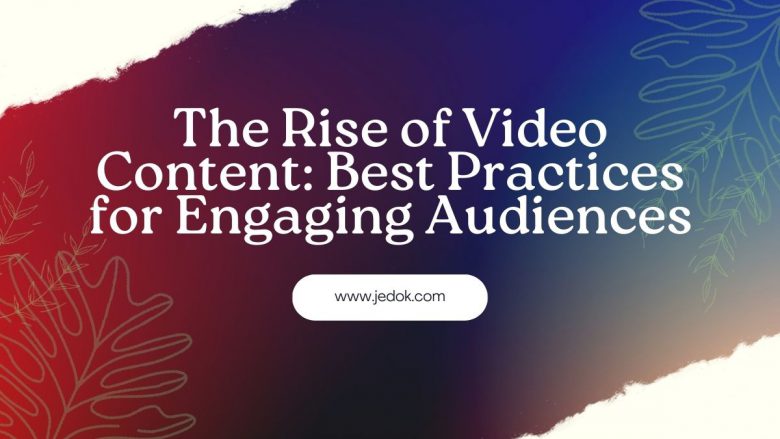
In the digital age, video content has become an increasingly popular and effective medium for engaging audiences. With platforms like YouTube, TikTok, and Instagram embracing video formats, businesses and marketers have a tremendous opportunity to connect with their target audience in a more captivating and interactive way. In this blog post, we will explore the rise of video content and delve into the best practices for creating engaging videos that leave a lasting impression on your audience.
1. Understand Your Audience:
Video content has become one of the most popular forms of media in recent years, and it’s no surprise why. Videos are versatile, and engaging, and can be used to convey complex messages simply and effectively. However, before diving into video production, it’s essential to understand your target audience. This is because different audiences have different preferences when it comes to video content.
Conducting thorough research is crucial to identifying your target audience. This involves analyzing data such as demographics, interests, and purchasing behavior to get a clear understanding of who your ideal customer is. Once you have identified your target audience, you can tailor your video content to meet their needs and preferences.
Understanding your audience also allows you to create more effective marketing campaigns that resonate with them on a deeper level.
2. Plan Your Video Content Strategy:
In today’s digital age, video content has become a crucial element of any successful marketing strategy. However, creating and posting random videos on your social media channels is not enough to achieve your business objectives. It is essential to have a well-planned video content strategy that aligns with your overall marketing goals.
Developing a video content strategy requires you to determine the type of videos that will resonate with your target audience, how frequently you will post them, and which platforms you will use. You also need to establish the tone and style of your videos, as well as how they fit into the larger picture of your brand messaging. By doing so, you can ensure that each video serves a specific purpose in achieving your desired business outcomes.
A well-crafted video content strategy enables businesses to showcase their products or services creatively while entertainingly engaging their audience.
3. Keep it Concise and Engaging:
Attention spans are shorter than ever, and that’s why it’s critical to keep your video content concise and engaging. With so many distractions fighting for viewers’ attention, it’s important to create videos that capture their interest from the outset and keep them engaged until the end.
One of the best ways to do this is by using storytelling techniques that draw viewers in right away. For example, you could start with a question or a provocative statement that piques their curiosity. From there, you can weave a narrative that keeps them hooked throughout the video.
Another key element of engaging video content is brevity. People simply don’t have the patience for long-winded videos anymore, so it’s essential to get your message across as quickly and efficiently as possible. This means cutting out any extraneous information or fluff and focusing on what really matters – conveying your core message clearly and compellingly.
4. Optimize for Mobile Viewing:
Video content has become a crucial aspect of digital marketing, and with the increasing use of mobile devices, optimizing it for mobile viewing is paramount. In today’s fast-paced world, people are constantly on the go, and they prefer to watch videos on their smartphones or tablets. As such, brands need to adapt their video content to suit this trend.
The first step in optimizing your videos for mobile viewing is ensuring that they are short and concise. People do not have the time or patience to sit through lengthy videos on their small screens. Therefore, aim for videos that are between 30 seconds to two minutes long. Additionally, ensure that they are visually appealing with high-quality graphics and clear audio. A poorly produced video can be frustrating to watch and cause viewership loss.
Another important element of optimizing video content for mobile devices is adapting it to different screen sizes.
5. Incorporate Branding Elements:
When it comes to building a brand, consistency is key. A brand that is well-defined and consistent across all platforms helps reinforce your identity and builds trust with your audience. How can you ensure that your branding remains consistent? By incorporating branding elements into all of your video content.
Start by using a consistent color scheme throughout all of your videos. Use your brand’s primary colors in the background, text graphics, and even clothing worn by any spokespersons or actors featured in the video. This will help viewers quickly associate the video with your brand.
Another important element to incorporate is your logo. Be sure to include it prominently at the beginning and end of every video. You can also include it as a watermark throughout the video to reinforce its association with your brand. Using branded music or sound effects can also help enhance the overall experience and create an emotional connection between viewers and your brand.
6. Leverage Storytelling Techniques:
Storytelling is an art form that has been around for centuries, and it remains a powerful tool for capturing and maintaining your audience’s attention. In today’s fast-paced digital age, video content has become the primary medium through which people consume information. Therefore, leveraging storytelling techniques in video content is essential to engage viewers and leave a lasting impact.
Crafting narratives that connect with your audience is crucial to keep them engaged throughout the video. Start by identifying the key message you want to convey and then build a story around it. You can use relatable characters or situations that resonate with your target audience to create emotional connections that will keep them invested in the narrative.
In addition, incorporating visual elements such as animation or graphics can enhance the storytelling experience. These visuals not only add context but also help break up long monologues or dialogue-heavy scenes that may lose viewers’ attention otherwise.
8. Experiment with Different Video Formats:
As consumers’ video consumption habits continue to evolve, it’s essential to experiment with different video formats to keep your audience engaged. Diversifying your video content by exploring various formats can help you reach new viewers and provide a more engaging experience for existing ones. By mixing shorter, snackable videos with longer-form content, you can tailor your message to match your audience’s preferences.
Shorter videos are the ideal format for social media platforms like Instagram and TikTok, where users scroll through their feeds at lightning speed. These snackable videos should be visually appealing and deliver a clear message in under 15 seconds. They’re perfect for highlighting product features or sharing quick tips and tricks that capture attention instantly. On platforms such as YouTube or Vimeo, longer-form content is more appropriate because users are often looking for in-depth tutorials or educational content they can watch at their own pace.
8. Promote and Distribute Strategically:
Creating high-quality video content is only half the battle. While it’s important to produce videos that are engaging, informative, and visually appealing, it’s equally crucial to promote and distribute them effectively. Without a strategic plan for getting your content in front of your target audience, your videos may go unnoticed and fail to generate the results you desire.
To maximize the impact of your video content, consider investing time and resources into developing a promotion and distribution strategy. This may include identifying key platforms where your target audience spends their time online (such as YouTube or social media), optimizing videos for search engines with relevant titles and descriptions, leveraging influencer partnerships or paid advertising opportunities, and tracking performance metrics to measure success.
Conclusion:
In the ever-evolving digital landscape, video content has risen as a powerful tool for engaging audiences. By understanding your audience, planning your video content strategy, creating concise and engaging videos, optimizing for mobile viewing, incorporating branding elements, leveraging storytelling techniques, experimenting with different formats, and promoting strategically, you can harness the power of video content to captivate your audience, foster deeper connections, and achieve your marketing objectives. Embrace the rise of video and unlock its potential to take your brand to new heights.


